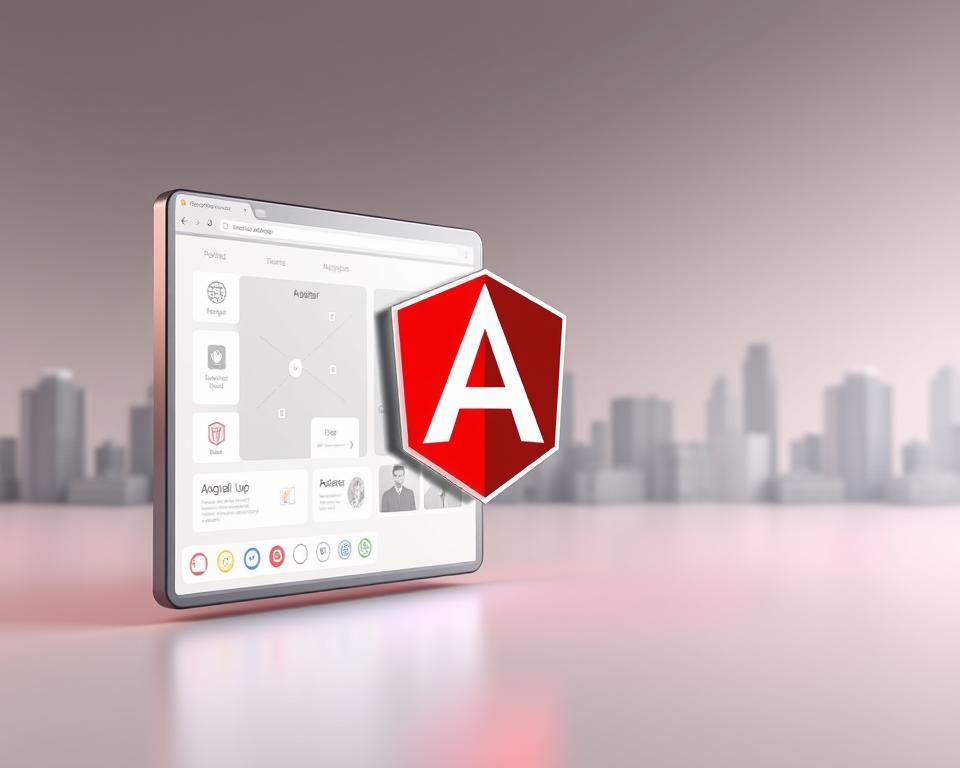In today’s digital world, making scalable web apps is key for businesses to keep up. Developers use strong Top web development frameworks to build top-notch apps.
Frameworks like React.js, Angular, and Vue.js are very popular. They make coding easier and apps run better.
Using these frameworks, developers can make web apps that grow with the digital world. These apps are easy to keep up and work well.
Table of Contents
Key Takeaways
- Scalable web apps are crucial for businesses to stay competitive.
- Web development frameworks simplify the development process.
- React.js, Angular, and Vue.js are popular frameworks for building scalable web apps.
- These frameworks improve application performance and maintainability.
- Leveraging the right framework is essential for success.
Understanding Scalability in Web Development
Scalability is key for web developers to make apps that grow with user needs and traffic. It means a web app can handle more users, data, and traffic without slowing down. A scalable app grows smoothly, keeping users happy.
What Makes a Web App Scalable
Several things make a web app scalable. Its design, tech stack, and performance are crucial. Scalable web applications have modular designs that let them add new resources easily. This, along with smart database and server setups, helps them grow well.
| Scalability Factor | Description | Impact on Scalability |
|---|---|---|
| Modular Architecture | Allows for the addition of new resources as needed | High |
| Efficient Database Design | Optimizes data retrieval and storage | High |
| Server Configuration | Affects how well the server handles increased load | Medium |
The Role of Frameworks in Scalability
Frameworks are vital for scalable web apps. They offer tools and best practices for building strong apps. Node.js and Express are great for scalable apps because of their efficient designs. They help apps handle lots of users without slowing down.
Key Factors to Consider When Choosing a Framework for Scalable Applications
Choosing the right framework is key for building scalable web apps. The framework is the base of the app, affecting its performance and growth. It’s important to pick one that supports scalability well.
Performance Metrics
When picking a framework, look at its performance. Metrics like response times and resource use are crucial. For example, Django is known for its speed and handling big traffic well. Optimizing for performance helps the app grow smoothly.
Community Support and Ecosystem
A strong community is essential for app success. A good community offers valuable resources like tools and support. React.js, for instance, has a big and active community. This support helps speed up development and solving issues.
“A strong community is the backbone of any successful open-source project.” –
Learning Curve and Developer Experience
The framework’s ease of use and developer experience matter a lot. A framework that’s easy to learn boosts team productivity. Vue.js, for example, is simple and easy to integrate, making it a favorite among developers.
- Ease of learning
- Documentation quality
- Community support
Enterprise Support and Long-term Viability
Support and long-term viability are key for scalable apps. Frameworks with strong support ensure updates and help over time. Angular, backed by Google, is a good example of this.
| Framework | Enterprise Support | Long-term Viability |
|---|---|---|
| Django | High | High |
| React.js | High | High |
| Vue.js | Medium | High |
Top Web Development Frameworks for Scalable Web Apps
Choosing the right framework is key for making web apps that grow with demand. Frameworks fall into frontend, backend, and full-stack categories. Each type has its own role and benefits.
Overview of Framework Categories
Frontend frameworks like React.js, Angular, and Vue.js focus on the client-side. They help build web pages that are interactive and easy to use.
Backend frameworks, such as Node.js with Express and Django, handle server-side tasks. They manage data, databases, and APIs, making the app’s backend scalable.
Full-stack frameworks, like Next.js and Meteor.js, cover both frontend and backend. They make it easier to build web apps that grow and adapt.
Selection Criteria for This List
We picked the top web development frameworks based on several important factors. Performance metrics were key, as they affect how well the app works and handles more users.
Community support and ecosystem were also important. A strong community offers resources and tools that help a framework grow and improve.
The learning curve and developer experience mattered too. Frameworks that are easy to learn and use save time and boost productivity.
Lastly, we looked at enterprise support and long-term viability. We wanted frameworks that have solid support and a clear future plan.
React.js: Building Scalable Frontend Applications
React.js has changed how we build frontend apps. It uses a virtual DOM to make complex interfaces easy to create.
Core Features and Architecture
React breaks down big UIs into small, easy-to-use parts. This makes big apps easier to handle and grow.
Its one-way data flow means updates only happen when needed. This cuts down on bugs and boosts speed.
React’s Virtual DOM and Performance Benefits
React’s virtual DOM is a quick, in-memory version of the real DOM. It makes updates faster by only changing what’s needed.
This virtual DOM also helps with server-side rendering and static site generation. It makes apps run smoother.
State Management Solutions for Scale
As apps get bigger, managing state becomes key. React has tools like Redux and MobX for this.
- Redux keeps all app state in one place
- MobX manages state reactively with less code
Real-world Examples of Large-scale React Applications
Big names like Facebook and Instagram use React. They show how it handles complex UIs well.
Netflix and Airbnb also use React. They’ve made their apps fast and smooth for users.
Angular: Enterprise-Grade Frontend Framework
Angular is a top choice for building complex web apps. It comes with a wide range of tools and features. This makes it perfect for creating scalable web applications.
TypeScript Integration and Strong Typing
Angular works well with TypeScript, which helps with strong typing. TypeScript’s type checking finds errors early. This is great for big apps where keeping things simple is key.
Dependency Injection and Modular Architecture
Angular’s design makes it easy to scale and organize apps. It uses a modular design to break down big apps into smaller parts. This makes it simpler to work on and maintain large projects.
Angular Universal for Server-Side Rendering
Angular Universal helps make apps load faster by rendering HTML on the server. Server-side rendering is a big plus for apps that need to load quickly.
Enterprise Adoption Case Studies
Many big companies use Angular for their web apps. For example,
“Google’s AdWords platform is built using Angular, showcasing the framework’s ability to handle complex, high-traffic applications.”
These examples show Angular’s power in supporting big, complex apps.
Vue.js: Progressive Framework for Scalable UIs
Vue.js makes it easy to build scalable UIs. It’s flexible and efficient, perfect for developers who want maintainable apps.
Reactivity System and Performance
Vue.js has a strong reactivity system for fast and predictable rendering. Its virtual DOM helps with quick updates, ideal for complex apps. This system is optimized for performance, letting developers focus on adding features.
Composition API and Scaling Strategies
The Composition API in Vue.js helps manage complexity and scale apps. It organizes code in a logical way, making it easier to scale applications without losing readability or maintainability.
Nuxt.js for Enhanced Vue Applications
Nuxt.js is built on Vue.js and boosts its features for server-side rendering and more. It offers a structured approach to building Vue applications, helping manage complexity and scale.
Vue.js in Production Environments
Vue.js is popular in production due to its scalability, maintainability, and performance. Companies have built complex, scalable apps with it, proving its worth for large-scale production environments.
Node.js and Express: Scalable Backend Development
Node.js and Express are key for making scalable backend apps. Node.js handles many requests at once thanks to its event-driven design. Express is a light, flexible framework for building APIs.
Event-Driven Architecture
Node.js’s event-driven model lets it handle lots of requests at once. This boosts app scalability and performance. It’s great for apps that need to update in real-time.
Key benefits of event-driven architecture include:
- Improved responsiveness under heavy loads
- Efficient handling of concurrent connections
- Simplified development of real-time features
Microservices Implementation with Express
Express.js is perfect for microservices because it’s light and flexible. Breaking an app into smaller services makes it more scalable and easier to manage.
A typical microservices architecture involves:
- Service decomposition
- Independent deployment of services
- Decentralized data management
Scaling Strategies for Node.js Applications
To scale Node.js apps, use clustering, load balancing, and optimize database queries. Clustering lets Node.js use more CPU cores, boosting performance.
Performance Monitoring and Optimization
Keeping an eye on performance is key for scalable Node.js apps. Tools like New Relic and Datadog help monitor app performance. They find bottlenecks and help optimize resources.
| Scaling Strategy | Description | Benefits |
|---|---|---|
| Clustering | Utilizing multiple CPU cores | Improved performance, better resource utilization |
| Load Balancing | Distributing incoming traffic | Enhanced availability, reduced server overload |
| Database Optimization | Optimizing database queries | Faster data retrieval, improved application performance |
Django: Python-Based Framework for Rapid Scalable Development
Django is a top Python web framework for quick, scalable app development. It offers an architecture, templates, and APIs for building strong web apps fast. Its design and features make it perfect for complex, data-driven sites.
ORM and Database Scalability
Django’s Object-Relational Mapping (ORM) system makes working with databases easier. It lets developers use Python instead of SQL. This makes it simpler to switch databases and supports MySQL, PostgreSQL, and SQLite.
The ORM also helps with database scaling. It manages connections and optimizes queries. This means Django apps can handle more traffic and big datasets.
Django REST Framework for API Development
The Django REST Framework is great for building Web APIs. It offers a simple way to create RESTful APIs. Key features include serialization, authentication, and pagination, making APIs scalable and easy to maintain.
Developers can quickly make APIs for different data formats with the Django REST Framework. This is key for web apps that need to work with many clients and services.
Caching and Performance Optimization
Caching is key for Django app performance. Django has a strong caching framework. It supports memory caching and systems like Redis. This reduces database queries and speeds up responses.
Improving Django app performance also means optimizing queries and using select_related and prefetch_related. Django also supports asynchronous tasks for better performance.
High-traffic Django Sites and Their Architecture
Many high-traffic sites use Django. Instagram and Pinterest are examples. They use load balancing, caching, and database sharding to scale their apps.
These sites show Django’s ability to handle large traffic. By learning from their architectures, developers can make their Django projects scalable and ready for growth.
Full-Stack Frameworks for End-to-End Scalability
Full-stack frameworks have become key for making web apps scalable. They offer a complete solution for building strong, scalable web apps. This makes development easier and reduces the complexity of using many tools and technologies.
Next.js for React Applications
Next.js is a top choice for React apps. It brings server-side rendering and static site generation to the table. This makes it easy to build fast, scalable apps.
- Server-Side Rendering: Boosts SEO and speeds up page loads.
- Static Site Generation: Pre-loads pages at build time, cutting server load.
- API Routes: Makes creating API endpoints simple.
Meteor.js and Real-time Applications
Meteor.js is great for making real-time apps. It has a reactive data layer that makes live updates easy.
Its main benefits are:
- Reactive Data: Updates clients automatically when server data changes.
- Isomorphic Code: Shares code between client and server, saving time.
Redwood.js and the JAMstack Approach
Redwood.js is a new framework that follows the JAMstack. It’s designed for building fast, scalable web apps.
Its standout features are:
- JAMstack Architecture: Boosts performance by serving pre-rendered markup and using CDNs.
- GraphQL API: Makes data fetching and manipulation easier.
Deployment and Scaling Strategies
Deploying and scaling full-stack apps involves several strategies. These include using Docker, Kubernetes, and serverless architectures.
Key deployment and scaling practices are:
- Monitoring and Logging: Crucial for understanding app performance and finding issues.
- Automated Testing: Keeps the app reliable and stable as it grows.
- Continuous Integration/Continuous Deployment (CI/CD): Makes development and deployment smoother.
Microservices Frameworks and Tools
Exploring microservices means looking at the frameworks and tools that make them work well. Microservices architecture is key for building systems that grow and improve. Many frameworks and tools support this approach.
Spring Cloud and Netflix OSS
Spring Cloud and Netflix OSS are top choices for Java microservices. Spring Cloud has tools for finding services, managing settings, and handling failures. Netflix OSS offers Eureka for finding services and Hystrix for handling failures.
Moleculer.js for Node.js Microservices
Moleculer.js is a Node.js framework for microservices. It has features like finding services, balancing loads, and handling faults. It works with JavaScript and TypeScript, giving developers options.
Service Mesh Solutions
Service mesh solutions add layers to microservices for better management. Istio and Linkerd are well-known for this. They work with many microservices frameworks, boosting their abilities.
Monitoring and Orchestration
Monitoring and managing microservices are crucial. Prometheus and Grafana are used for watching over services. Kubernetes is key for managing services, ensuring they run smoothly and grow well.
| Framework/Tool | Primary Use | Key Features |
|---|---|---|
| Spring Cloud | Java Microservices | Service discovery, configuration management, circuit breakers |
| Netflix OSS | Java Microservices | Service discovery (Eureka), circuit breaking (Hystrix) |
| Moleculer.js | Node.js Microservices | Service discovery, load balancing, fault tolerance |
| Istio | Service Mesh | Traffic management, security, observability |
| Kubernetes | Orchestration | Container orchestration, scaling, management |
Cloud Integration and Containerization
In today’s digital world, cloud integration and containerization are key for making web apps scalable and efficient. As businesses grow online, they need strong infrastructure to handle more traffic and demand.
Docker and Kubernetes for Scalable Deployments
Docker and Kubernetes are big in containerization, helping deploy and scale web apps. Docker packages apps into containers that are easy to move around. Kubernetes then manages these containers, making sure they run smoothly and are always available.
“Kubernetes is now the top choice for managing containers,” say experts. It’s known for being scalable and flexible for modern web apps.
Serverless Frameworks and Architecture
Serverless frameworks like AWS Lambda are great for building apps without worrying about servers. They let developers focus on coding, while the cloud handles scaling and setup.
Serverless architecture is popular because it cuts down on work and boosts scalability. AWS Lambda shows how it lets apps grow to meet demand automatically.
Cloud-native Development Patterns
Cloud-native development uses cloud computing to make apps scalable and strong. It designs apps for the cloud, using cloud storage and databases.
- Microservices architecture
- Containerization
- Service mesh
Multi-region Deployment Strategies
Putting apps in many regions is key for high availability and low latency. Cloud providers’ global networks help apps reach users faster, improving performance.
As cloud tech grows, developers must use strategies that boost scalability, reliability, and performance. With Docker, Kubernetes, and serverless, businesses can create apps that keep up with the fast-changing digital world.
Performance Optimization Frameworks and Tools
Web developers focus on making websites fast and smooth. They use frameworks and tools to boost speed and quality. This makes the user experience better.
GraphQL for Efficient Data Fetching
GraphQL is a top choice for better data fetching. It lets clients ask for only the data they need. This cuts down on data size and boosts performance.
Key Benefits of GraphQL:
- Reduced payload size
- Improved data fetching efficiency
- Enhanced flexibility in data querying
Web Workers and Multithreading
Web workers make web apps faster by handling tasks in the background. This keeps the main thread free for user actions. It makes the app more responsive.
Benefits of Web Workers:
- Improved responsiveness
- Enhanced multitasking capabilities
- Better utilization of multi-core processors
Progressive Web App Frameworks
Progressive Web App (PWA) frameworks help build fast and reliable web apps. They offer offline support, push notifications, and more. This makes the app better for users.
PWA Frameworks:
| Framework | Key Features |
|---|---|
| PWA Builder | Offline support, push notifications |
| Workbox | Offline capabilities, caching strategies |
Monitoring and Analytics Integration
Monitoring and analytics are key for improving performance. Tools like Google Analytics and New Relic give insights. They help find and fix performance issues.
Key Monitoring and Analytics Tools:
- Google Analytics
- New Relic
- Datadog
Emerging Frameworks for Future-Proof Scalability
New frameworks are changing how we make web apps. They focus on making apps faster, safer, and easier to use. These new tools help solve old problems, making apps better and more reliable.
Svelte and SvelteKit
Svelte is a special framework that makes code run faster and smaller. It turns declarative code into efficient JavaScript. SvelteKit adds more features like server-side rendering for building big web apps.
Deno and Fresh Framework
Deno is a new JavaScript runtime that’s safer and follows web standards better. The Fresh Framework uses Deno to make web apps fast and secure. It has cool features like just-in-time compilation.
WebAssembly-Based Frameworks
WebAssembly (WASM) makes web apps run super fast. With frameworks like Blazor, you can write apps in C# and .NET. They run in the browser, making complex apps possible.
AI-assisted Development Tools
AI-assisted development tools are changing web development. They help with code, find bugs, and suggest improvements. As AI gets better, these tools will make coding even easier.
Conclusion
Building scalable web applications is a complex task. It requires careful consideration of various factors. These include framework selection, architecture, and performance optimization.
The frameworks discussed in this article provide a solid foundation. They help build scalable, enterprise-grade web apps.
When choosing a Top web development frameworks, it’s essential to consider several factors. These include performance metrics, community support, and learning curve. By understanding each framework’s strengths and weaknesses, developers can create high-performance, scalable applications.
These applications meet the demands of today’s digital landscape.
Ultimately, the right web development framework is crucial. By adopting best practices and leveraging the right tools, developers can ensure their applications are scalable and maintainable. They also meet the needs of their users.



















